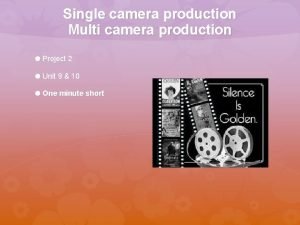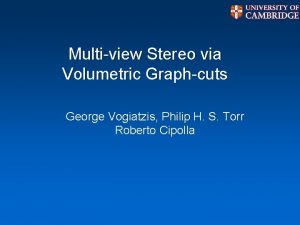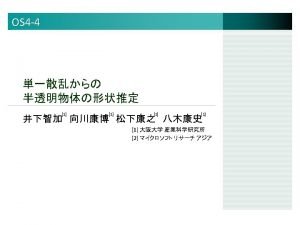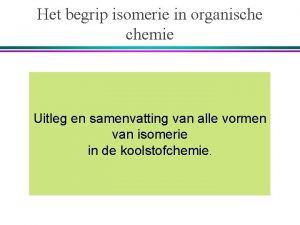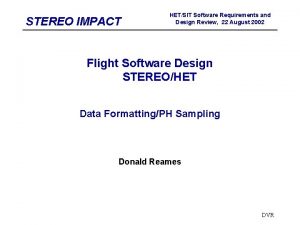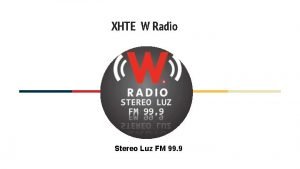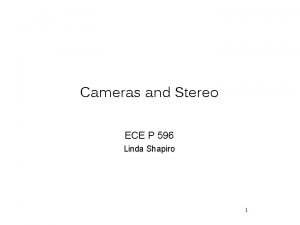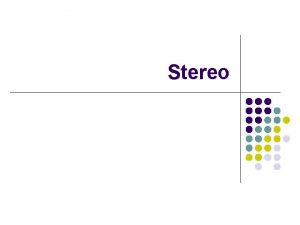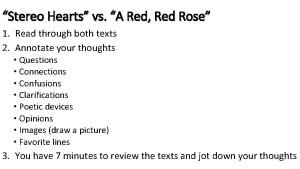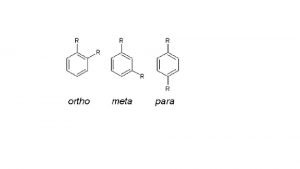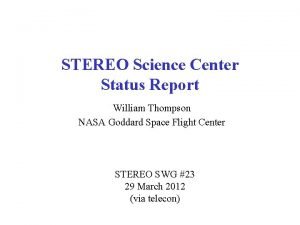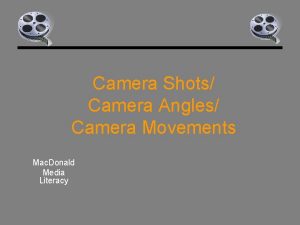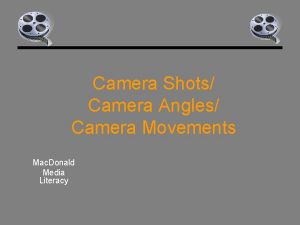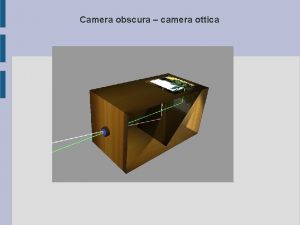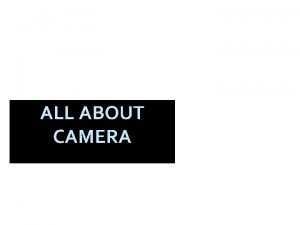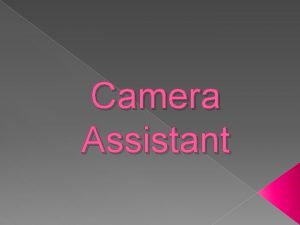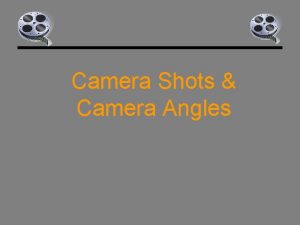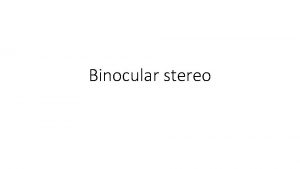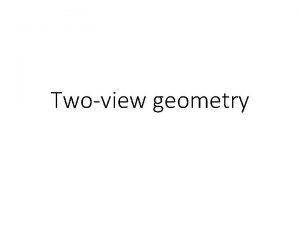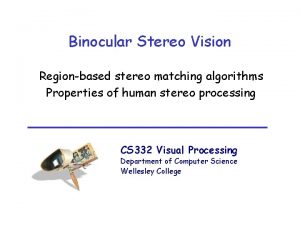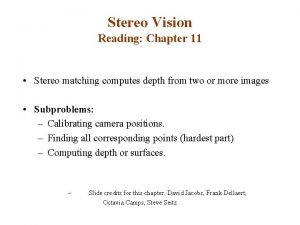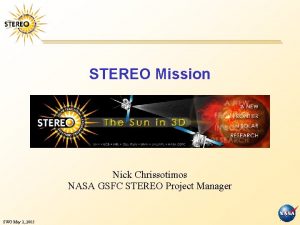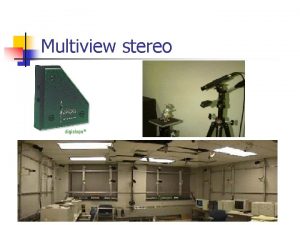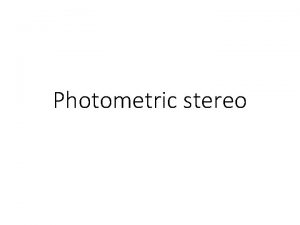3 DPIXA 3 D stereo camera Stereo line
























- Slides: 24


3 D-PIXA 3 D stereo camera • Stereo line scan camera • 3 D data and color image simultaneously

PIXA family basic features Features • CCD: tri-linear color line scan sensor • 10 µm pixel size • Resolutions: • 7300 @ 22 k. Hz • 4096 @ 36 k. Hz • 2048 @ 66 k. Hz • 1024 @ 100 k. Hz • 3 x 170 MByte/s (=510 MByte/s) • Camera. Link Medium

Overview Stereoscopic approach • Calibrated stereo line scan camera • Height in real time with GPU Line-scan camera Height + image Features • RGB images and height map • Modular system concept for custom specific solutions • Quality and performance based on all. PIXA Surface of object Linear movement

Customer benefit 1/2 Highest resolutions (max 7 k per line) • Large formats • High lateral resolutions • Height resolution up to 10 x better than lateral resolution Line-scan approach Ideal for fast moving objects Ideal for 100% inspection

Benefit 2/2 High speeds (up to 60. 000 lines/s) Highly configurable • Via lens system • Resolution from 10 µm to 700 µm • lens defines the resolution Output • Color image (rectified) • Height map (16 Bit image) • Point cloud

Functional principle Stereo correspondence • Find corresponding points in both images using correlation (texture based) • Result from correlation is disparity map • Height is calculated from disparity map using calibration data • Correlation is performed on GPU

Stereo approach: Principle Two images from the same scene • Object surface P Both cameras takes the same scene two different viewing angles Z • One point on the surface P is projected in both images (Pl und Pr) • Calculation of height based on triangulation b c Pl Left Camera • Standard stereo approach Parallel cameras and sensors Right camera r Z: distance p: Parallax b: Basis of stereo system c: Image distance P p = xl - xr

Stereo approach: Principle Parallaxe p • Object surface P different viewing angles results in parallax Z Z: Distance b: Basis of stereo system b c: Image distance p: Parallax p = xl - xr 9 Pl xl c xr Pr Parallax p

10 Stereo approach: Correspondence Corresponding points • Stereo image acquisition: two images • Finding corresponding points Pattern matching • Left image: take ROI around Pl as pattern • Search for best match of pattern in the right image • Position with best match is resulting correspondence

Stereo approach: Correspondence right image Left image Correlation 1 1 Position of the ROI

Samples Embossing on package Soldering on a normal electronic board Wood board with relief structure

Samples: Euro coin 3 D visualized with 10 µm optical resolution 1 µm height resolution

Samples: Euro coin Height map in pseudo color 10 µm optical resolution 1 µm height resolution

Samples: banknote in-taglio print 10 µm optical resolution 1 µm height resolution

System options 1/2 3 D-PIXA-C 15 Resolution: 15 µm Height resolution: 3 µm Scan width: 40 mm Height range: 1 mm Max. speed: 0. 3 m/s 3 D-PIXA-C 30 Resolution: Height resolution: Scan width: Height range: Max. speed: 30 µm 6 µm 105 mm 3 mm 0. 6 m/s

System options 2/2 3 D-PIXA dual • Dual line-scan camera • Flexible in base width • Support for 10 – 700 µm • Max. 60 k. Hz • Usable pixels: max. 7000 • Available for project solutions

System options 2/2 Example configurations 3 D-PIXA-D 70 Resolution: 70 µm Height resolution: 20 µm Scan width: 500 mm Height range: 30 mm Max. speed: 1. 5 m/s 3 D-PIXA-D 680 Resolution: 680 µm Height resolution: 200 µm Scan width: 2000 mm Height range: 700 mm Max. speed: 25 m/s

System configuration HW Imaging PC Camera. Link PC Bus 3 D calculation (API) origin Color image Height image Application software Image analysis

System configuration Calculation of 3 D height information • Depends on: • Height range • Number of graphic boards • Line length (4 K for this sample calculation) 4 k systems 2 k systems max. 60 k. Hz

21 3 D-PIXA vs. Laser scanner: Illumination Laser approach 3 D-PIXA - standard light source no specles

22 3 D-PIXA vs. Laser scanner: Illumination 3 D-PIXA Dark-field Bright-field Cloudy-day (dome) Co-axial

3 D-PIXA vs. Laser scanner: Illumination speed 23 range High speed only for • • Low resolution (1/2 pixel) Small range (< 100 rows) 3 D-PIXA • always 21 k. Hz (up to 60 k. Hz) Sensor rows => range

Why choose 3 D PIXA Unique performance ü 3 D and 2 D color simultaneously ü Highest resolutions, widths and speeds ü Ideal for 100% inspection ü Ideal for fast moving objects ü Flexible as line-scan cameras ü Registration of texture and 3 D height ü Powered by Chromasens all. PIXA technology
 Multi camera production examples
Multi camera production examples Single camera vs multi camera
Single camera vs multi camera A plain scale of 1cm=5m and show on it 37m
A plain scale of 1cm=5m and show on it 37m Multiview stereo
Multiview stereo Singular plural noun
Singular plural noun Photometric stereo
Photometric stereo Stereo isomerie
Stereo isomerie Stereo
Stereo Would you mind turning down the radio
Would you mind turning down the radio Would you mind turning off the tv
Would you mind turning off the tv Tcp stereo
Tcp stereo Amarc
Amarc Stereo
Stereo Do you mind turn off the music
Do you mind turn off the music Ronen basri
Ronen basri Fusion stereo problems
Fusion stereo problems What is a simile in stereo hearts
What is a simile in stereo hearts Stereo isomeria
Stereo isomeria Rhyme scheme in stereo hearts
Rhyme scheme in stereo hearts Similes in stereo hearts
Similes in stereo hearts Stereo science center
Stereo science center Spiegelbeeldisomerie cyclisch
Spiegelbeeldisomerie cyclisch =
= Money madness by dh lawrence
Money madness by dh lawrence A prayer for all my countrymen poem theme
A prayer for all my countrymen poem theme

